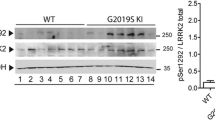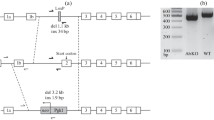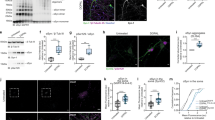Abstract
Familial Parkinson’s disease (PD) has been linked to point mutations and duplication of the α-synuclein gene and mutant α-synuclein expression increases the vulnerability of neurons to exogenous insults. In this study, we analyzed the levels of dopamine and its metabolites in the olfactory bulb (OB), and nigrostriatal regions of transgenic mice expressing human, mutant A53T α-synuclein (α-syn tg) and their non-transgenic (ntg) littermates using a sub-toxic, moderate dose of MPTP to determine if mutant human α-synuclein sensitizes the central dopaminergic systems to oxidative stress. We observed that after a single, sub-lethal MPTP injection, dopamine levels were reduced in striatum and SN in both the α-syn tg and ntg mice. In the olfactory bulb, a region usually resistant to MPTP toxicity, levels were reduced only in the α-syn tg mice. In addition, we identified a significant increase in dopamine metabolism in the α-syn transgenic, but not ntg mice. Finally, MPTP treatment of α-syn tg mice was associated with a marked elevation in the oxidative product, 3-nitrotyrosine that co-migrated with α-synuclein. Cumulatively, the data support the hypothesis that mutant α-synuclein sensitizes dopaminergic neurons to neurotoxic insults and is associated with greater oxidative stress. The α-syn tg line is therefore useful to study the genetic and environmental inter-relationship in PD.




Similar content being viewed by others
Abbreviations
- DA:
-
Dopamine
- DOPAC:
-
Homovanillic acid
- HVA:
-
Dihydroxyphenyl-acetic acid
- ip:
-
Intraperitoneal
- LB:
-
Lewy body
- MANOVA:
-
Multivariant analysis of variance
- MPP+ :
-
1-Methyl-4-phenylpyridinium
- MPTP:
-
1-Methyl-4-phenyl-1,2,3,6-tetrahydropyridine
- ntg:
-
Non-transgenic
- 3-NT:
-
3-Nitrotyrosine
- PD:
-
Parkinson’s disease
- TH:
-
Tyrosine hydroxylase
- α-syn tg:
-
Human mutant α-synuclein (A53T) transgenic mouse
References
Polymeropoulos MH (1998) Autosomal dominant Parkinson’s disease. J Neurol 245:P1–P3
Kruger R, Kuhn W, Leenders KL et al (2001) Familial parkinsonism with synuclein pathology: clinical and PET studies of A30P mutation carriers. Neurology 56:1355–1362
Kruger R, Kuhn W, Muller T et al (1998) Ala30Pro mutation in the gene encoding alpha-synuclein in Parkinson’s disease. Nat Genet 18:106–108
Spillantini MG, Schmidt ML, Lee VM, Trojanowski JQ, Jakes R, Goedert M (1997) Alpha-synuclein in Lewy bodies. Nature 388:839–840
Spillantini MG, Crowther RA, Jakes R, Hasegawa M, Goedert M (1998) alpha-Synuclein in filamentous inclusions of Lewy bodies from Parkinson’s disease and dementia with lewy bodies. Proc Natl Acad Sci USA 95:6469–6473
Giasson BI, Uryu K, Trojanowski JQ, Lee VM (1999) Mutant and wild type human alpha-synucleins assemble into elongated filaments with distinct morphologies in vitro. J Biol Chem 274:7619–7622
Bonini NM, Giasson BI (2005) Snaring the function of alpha-synuclein. Cell 123:359–361
Wakabayashi K, Matsumoto K, Takayama K, Yoshimoto M, Takahashi H (1997) NACP, a presynaptic protein, immunoreactivity in Lewy bodies in Parkinson’s disease. Neurosci Lett 239:45–48
Goedert M, Spillantini MG (1998) Lewy body diseases and multiple system atrophy as alpha-synucleinopathies. Mol Psychiatry 3:462–465
Irizarry MC, Growdon W, Gomez-Isla T, Newell K, George JM, Clayton DF, Hyman BT (1998) Nigral and cortical Lewy bodies and dystrophic nigral neurites in Parkinson’s disease and cortical Lewy body disease contain alpha-synuclein immunoreactivity. J Neuropathol Exp Neurol 57:334–337
Giasson BI, Duda JE, Quinn SM, Zhang B, Trojanowski JQ, Lee VM (2002) Neuronal alpha-synucleinopathy with severe movement disorder in mice expressing A53T human alpha-synuclein. Neuron 34:521–533
Feany MB (2004) New genetic insights into Parkinson’s disease. N Engl J Med 351:1937–1940
Masliah E, Rockenstein E, Veinbergs I, Mallory M, Hashimoto M, Takeda A, Sagara Y, Sisk A, Mucke L (2000) Dopaminergic loss and inclusion body formation in alpha-synuclein mice: implications for neurodegenerative disorders. Science 287:1265–1269
van der Putten H, Wiederhold KH, Probst A et al (2000) Neuropathology in mice expressing human alpha-synuclein. J Neurosci 20:6021–6029
Matsuoka Y, Vila M, Lincoln S et al (2001) Lack of nigral pathology in transgenic mice expressing human alpha-synuclein driven by the tyrosine hydroxylase promoter. Neurobiol Dis 8:535–539
Jenner P, Olanow CW (1998) Understanding cell death in Parkinson’s disease. Ann Neurol 44:S72–S84
Di Monte DA (2003) The environment and Parkinson’s disease: is the nigrostriatal system preferentially targeted by neurotoxins? Lancet Neurol 2:531–538
Di Monte DA, Lavasani M, Manning-Bog AB (2002) Environmental factors in Parkinson’s disease. Neurotoxicology 23:487–502
Zhou W, Hurlbert MS, Schaack J, Prasad KN, Freed CR (2000) Overexpression of human alpha-synuclein causes dopamine neuron death in rat primary culture and immortalized mesencephalon-derived cells. Brain Res 866:33–43
Lehmensiek V, Tan EM, Liebau S, Lenk T, Zettlmeisl H, Schwarz J, Storch A (2006) Dopamine transporter-mediated cytotoxicity of 6-hydroxydopamine in vitro depends on expression of mutant alpha-synucleins related to Parkinson’s disease. Neurochem Int 48:329–340
Gomez-Santos C, Ferrer I, Reiriz J, Vinals F, Barrachina M, Ambrosio S (2002) MPP+ increases alpha-synuclein expression and ERK/MAP-kinase phosphorylation in human neuroblastoma SH-SY5Y cells. Brain Res 935:32–39
Przedborski S, Chen Q, Vila M et al (2001) Oxidative post-translational modifications of alpha-synuclein in the 1-methyl-4-phenyl-1,2,3,6-tetrahydropyridine (MPTP) mouse model of Parkinson’s disease. J Neurochem 76:637–640
Chau YP, Lin SY, Chen JH, Tai MH (2003) Endostatin induces autophagic cell death in EAhy926 human endothelial cells. Histol Histopathol 18:715–726
Song DD, Shults CW, Sisk A, Rockenstein E, Masliah E (2004) Enhanced substantia nigra mitochondrial pathology in human alpha-synuclein transgenic mice after treatment with MPTP. Exp Neurol 186:158–172
Nieto M, Gil-Bea FJ, Dalfo E et al (2006) Increased sensitivity to MPTP in human alpha-synuclein A30P transgenic mice. Neurobiol Aging 27:848–856
Kanda S, Bishop JF, Eglitis MA, Yang Y, Mouradian MM (2000) Enhanced vulnerability to oxidative stress by alpha-synuclein mutations and C-terminal truncation. Neuroscience 97:279–284
Ko L, Mehta ND, Farrer M, Easson C, Hussey J, Yen S, Hardy J, Yen SH (2000) Sensitization of neuronal cells to oxidative stress with mutated human alpha-synuclein. J Neurochem 75:2546–2554
Lee FJ, Liu F, Pristupa ZB, Niznik HB (2001) Direct binding and functional coupling of alpha-synuclein to the dopamine transporters accelerate dopamine-induced apoptosis. Faseb J 15:916–926
Choi JY, Jang EH, Park CS, Kang JH (2005) Enhanced susceptibility to 1-methyl-4-phenyl-1,2,3,6-tetrahydropyridine neurotoxicity in high-fat diet-induced obesity. Free Radic Biol Med 38:806–816
Duda JE, Giasson BI, Chen Q et al (2000) Widespread nitration of pathological inclusions in neurodegenerative synucleinopathies. Am J Pathol 157:1439–1445
Giasson BI, Duda JE, Murray IV, Chen Q, Souza JM, Hurtig HI, Ischiropoulos H, Trojanowski JQ, Lee VM (2000) Oxidative damage linked to neurodegeneration by selective alpha-synuclein nitration in synucleinopathy lesions. Science 290:985–989
Mihm MJ, Schanbacher BL, Wallace BL, Wallace LJ, Uretsky NJ, Bauer JA (2001) Free 3-nitrotyrosine causes striatal neurodegeneration in vivo. J Neurosci 21:RC149
Vila M, Vukosavic S, Jackson-Lewis V, Neystat M, Jakowec M, Przedborski S (2000) Alpha-synuclein up-regulation in substantia nigra dopaminergic neurons following administration of the parkinsonian toxin MPTP. J Neurochem 74:721–729
Fornai F, Schluter OM, Lenzi P et al (2005) Parkinson-like syndrome induced by continuous MPTP infusion: convergent roles of the ubiquitin-proteasome system and alpha-synuclein. Proc Natl Acad Sci USA 102:3413–3418
Wullner U, Pakzaban P, Brownell AL et al (1994) Dopamine terminal loss and onset of motor symptoms in MPTP-treated monkeys: a positron emission tomography study with 11C-CFT. Exp Neurol 126:305–309
Purisai MG, McCormack AL, Langston WJ, Johnston LC, Di Monte DA (2005) Alpha-synuclein expression in the substantia nigra of MPTP-lesioned non-human primates. Neurobiol Dis 20:898–906
Langston JW, Forno LS, Rebert CS, Irwin I (1984) Selective nigral toxicity after systemic administration of 1-methyl-4-phenyl-1,2,5,6-tetrahydropyrine (MPTP) in the squirrel monkey. Brain Res 292:390–394
Davis GC, Williams AC, Markey SP, Ebert MH, Caine ED, Reichert CM, Kopin IJ (1979) Chronic Parkinsonism secondary to intravenous injection of meperidine analogues. Psychiatry Res 1:249–254
Itzhak Y, Mash D, Zhang SH, Stein I (1991) Characterization of N-methyl-4-phenyl-1,2,3,6-tetrahydropyridine (MPTP) binding sites in C57BL/6 mouse brain: mutual effects of monoamine oxidase inhibitors and sigma ligands on MPTP and sigma binding sites. Mol Pharmacol 39:385–393
Tipton KF, Singer TP (1993) Advances in our understanding of the mechanisms of the neurotoxicity of MPTP and related compounds. J Neurochem 61:1191–1206
Dunigan CD, Shamoo AE (1996) Identification of the major transport pathway for the parkinsonism-inducing neurotoxin 1-methyl-4-phenylpyridinium. Neuroscience 75:37–41
Suzuki K, Mizuno Y, Yoshida M (1990) Effects of 1-methyl-4-phenyl-1,2,3,6-tetrahydropyridine (MPTP)-like compounds on mitochondrial respiration. Adv Neurol 53:215–218
Przedborski S, Jackson-Lewis V, Djaldetti R, Liberatore G, Vila M, Vukosavic S, Almer G (2000) The parkinsonian toxin MPTP: action and mechanism. Restor Neurol Neurosci 16:135–142
Jellinger KA (1991) Pathology of Parkinson’s disease. Changes other than the nigrostriatal pathway. Molecular and chemical neuropathology/sponsored by the International Society for Neurochemistry and the World Federation of Neurology and Research Groups on Neurochemistry and Cerebrospinal fluid 14:153–197
Lehrner J, Brucke T, Kryspin-Exner I, Asenbaum S, Podreka I (1995) Impaired olfactory function in Parkinson’s disease. Lancet 345:1054–1055
Hawkes C (2006) Olfaction in neurodegenerative disorder. Adv Otorhinolaryngol 63:133–151
Westervelt HJ, Stern RA, Tremont G (2003) Odor identification deficits in diffuse lewy body disease. Cogn Behav Neurol 16:93–99
Pearce RK, Hawkes CH, Daniel SE (1995) The anterior olfactory nucleus in Parkinson’s disease. Mov Disord 10:283–287
Haehner A, Hummel T, Hummel C, Sommer U, Junghanns S, Reichmann H (2007) Olfactory loss may be a first sign of idiopathic Parkinson’s disease. Mov Disord 22:839–842
Markopoulou K, Larsen KW, Wszolek EK, Denson MA, Lang AE, Pfeiffer RF, Wszolek ZK (1997) Olfactory dysfunction in familial parkinsonism. Neurology 49:1262–1267
Ward CD, Hess WA, Calne DB (1983) Olfactory impairment in Parkinson’s disease. Neurology 33:943–946
Doty RL, Singh A, Tetrud J, Langston JW (1992) Lack of major olfactory dysfunction in MPTP-induced parkinsonism. Ann Neurol 32:97–100
Dluzen DE (1992) 1-Methyl-4-phenyl-1,2,3,6-tetrahydropyridine (MPTP) reduces norepinephrine concentrations in the olfactory bulbs of male mice. Brain Res 586:144–147
Dluzen DE, Kefalas G (1996) The effects of intranasal infusion of 1-methyl-4-phenyl-1,2,3,6-tetrahydropyridine (MPTP) upon catecholamine concentrations within olfactory bulbs and corpus striatum of male mice. Brain Res 741:215–219
Sziraki I, Kardos V, Patthy M, Patfalusi M, Budai G (1994) Methamphetamine protects against MPTP neurotoxicity in C57BL mice. Eur J Pharmacol 251:311–314
Rathke-Hartlieb S, Kahle PJ, Neumann M, Ozmen L, Haid S, Okochi M, Haass C, Schulz JB (2001) Sensitivity to MPTP is not increased in Parkinson’s disease-associated mutant alpha-synuclein transgenic mice. J Neurochem 77:1181–1184
Dong Z, Ferger B, Feldon J, Bueler H (2002) Overexpression of Parkinson’s disease-associated alpha-synucleinA53T by recombinant adeno-associated virus in mice does not increase the vulnerability of dopaminergic neurons to MPTP. J Neurobiol 53:1–10
Richfield EK, Thiruchelvam MJ, Cory-Slechta DA, Wuertzer C, Gainetdinov RR, Caron MG, Di Monte DA, Federoff HJ (2002) Behavioral and neurochemical effects of wild-type and mutated human alpha-synuclein in transgenic mice. Exp Neurol 175:35–48
Jenner P, Olanow CW (1996) Oxidative stress and the pathogenesis of Parkinson’s disease. Neurology 47:S161–S170
Hornykiewicz O, Kish SJ (1987) Biochemical pathophysiology of Parkinson’s disease. Adv Neurol 45:19–34
Sershen H, Mason MF, Hashim A, Lajtha A (1985) Effect of N-methyl-4-phenyl-1,2,3,6-tetrahydropyridine (MPTP) on age-related changes in dopamine turnover and transporter function in the mouse striatum. Eur J Pharmacol 113:135–136
Dalfo E, Martinez A, Muntane G, Ferrer I (2006) Abnormal alpha-synuclein solubility, aggregation and nitration in the frontal cortex in Pick’s disease. Neurosci Lett 400:125–129
Ischiropoulos H (2003) Oxidative modifications of alpha-synuclein. Ann NY Acad Sci 991:93–100
Wilson CA, Murphy DD, Giasson BI, Zhang B, Trojanowski JQ, Lee VM (2004) Degradative organelles containing mislocalized alpha-and beta-synuclein proliferate in presenilin-1 null neurons. J Cell Biol 165:335–346
Masliah E, Rockenstein E, Adame A et al (2005) Effects of alpha-synuclein immunization in a mouse model of Parkinson’s disease. Neuron 46:857–868
Rockenstein E, Schwach G, Ingolic E et al (2005) Lysosomal pathology associated with alpha-synuclein accumulation in transgenic models using an eGFP fusion protein. J Neurosci Res 80:247–259
Stefanis L, Larsen KE, Rideout HJ, Sulzer D, Greene LA (2001) Expression of A53T mutant but not wild-type alpha-synuclein in PC12 cells induces alterations of the ubiquitin-dependent degradation system, loss of dopamine release, and autophagic cell death. J Neurosci 21:9549–9560
Cuervo AM, Stefanis L, Fredenburg R, Lansbury PT, Sulzer D (2004) Impaired degradation of mutant alpha-synuclein by chaperone-mediated autophagy. Science 305:1292–1295
Clayton DF, George JM (1999) Synucleins in synaptic plasticity and neurodegenerative disorders. J Neurosci Res 58:120–129
Kobayashi H, Kruger R, Markopoulou K et al (2003) Haploinsufficiency at the alpha-synuclein gene underlies phenotypic severity in familial Parkinson’s disease. Brain 126:32–42
Neystat M, Lynch T, Przedborski S, Kholodilov N, Rzhetskaya M, Burke RE (1999) Alpha-synuclein expression in substantia nigra and cortex in Parkinson’s disease. Mov Disord 14:417–422
Klivenyi P, Siwek D, Gardian G et al (2006) Mice lacking alpha-synuclein are resistant to mitochondrial toxins. Neurobiol Dis 21:541–548
Dauer W, Kholodilov N, Vila M et al (2002) Resistance of alpha -synuclein null mice to the parkinsonian neurotoxin MPTP. Proc Natl Acad Sci USA 99:14524–14529
Author information
Authors and Affiliations
Corresponding author
Rights and permissions
About this article
Cite this article
Yu, W.H., Matsuoka, Y., Sziráki, I. et al. Increased Dopaminergic Neuron Sensitivity to 1-Methyl-4-Phenyl-1,2,3,6-Tetrahydropyridine (MPTP) in Transgenic Mice Expressing Mutant A53T α-Synuclein. Neurochem Res 33, 902–911 (2008). https://doi.org/10.1007/s11064-007-9533-4
Received:
Accepted:
Published:
Issue Date:
DOI: https://doi.org/10.1007/s11064-007-9533-4




